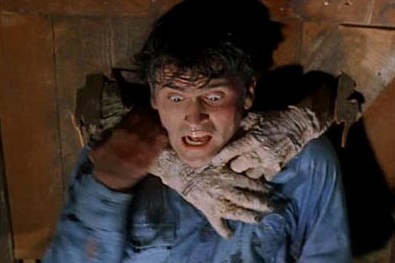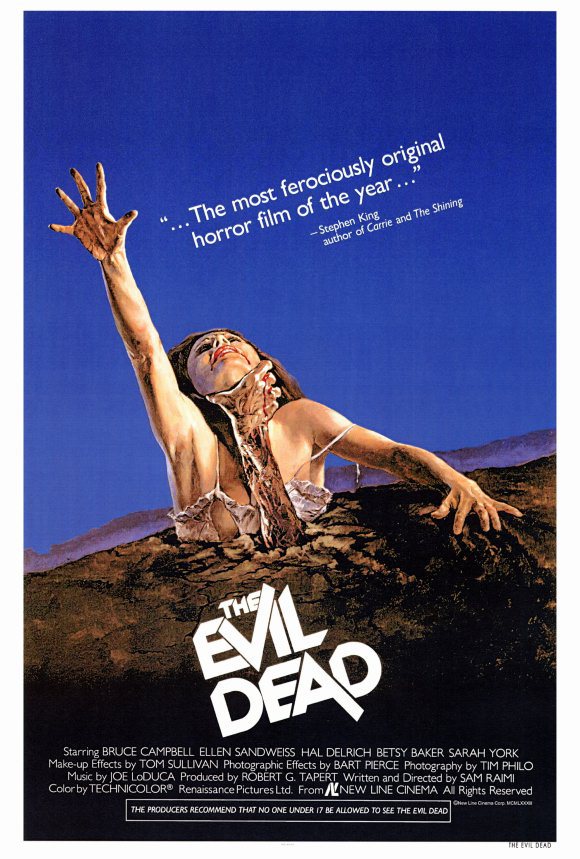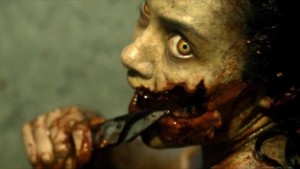THE EVIL DEAD (1981); Dir. Sam Raimi; Starring Bruce Campbell, Ellen Sandweiss, Hal Delrich, Betsy Baker and Sarah York; Available on DVD and Blu-Ray from Anchor Bay Entertainment; Trailer here.
By Aleck Bennett
Contributing Writer
There’s such a hue and cry over the seemingly unending parade of remakes coming out of the Hollywood horror entertainment complex. It’s increasingly hard to approach one on its own terms without feeling like you’re betraying all that is good and true in this world. And when it comes to a beloved horror classic like Sam Raimi’s 1981 gorefest THE EVIL DEAD, the stakes are raised even higher.
But here’s the complication: THE EVIL DEAD has already been remade. Not once, but twice. The film’s plot was summarized and streamlined into the first quarter hour or so of 1987’s EVIL DEAD II, which was then subsequently summarized and streamlined into the opening segment of the series’ third film, 1992’s ARMY OF DARKNESS. Further complicating matters is the fact that THE EVIL DEAD is itself a remake. Raimi’s 1978 short film WITHIN THE WOODS was developed as a prototype horror film to draw investors, and it successfully led to Raimi raising the nearly $100,000 needed to develop a feature-length version of the short.
To be clear: THE EVIL DEAD is far from being some sacred, untouchable text. Not even Raimi sees it as being one, as he’s been futzing around with the same story since 1978. And even then it wasn’t that original an idea: though Raimi denies having seen the film prior to production, the storyline of THE EVIL DEAD is relatively close to that of the 1967-70 drive-in classic EQUINOX. Both involve scientists who have unwittingly opened a portal between this world and a demonic realm, a mysterious occult text and a handful of early-20s youths who visit the scientist’s cabin and wind up fighting off demons. It’s become such an archetypal setup that the “five kids in a cabin” trope is the basis for Joss Whedon and Drew Goddard’s ultimate meta horror-comedy, 2012’s THE CABIN IN THE WOODS.
That being said, how does Fede Alvarez’s 2013 version compare with the 1981 model? Let’s take a look.
 Both stories are superficially similar: a group of five kids in their 20s visit a remote cabin, wherein they stumble upon a mysterious tome, the NATURON DEMONTO, which contains passages intended to open a portal and summon demons to this realm. The spells are read aloud (in the original, played via a scientist’s tape recording; in the 2013 version, directly read from the book), and said demons are summoned. One by one, the five are picked off and controlled by the ancient evil called forth by the book.
Both stories are superficially similar: a group of five kids in their 20s visit a remote cabin, wherein they stumble upon a mysterious tome, the NATURON DEMONTO, which contains passages intended to open a portal and summon demons to this realm. The spells are read aloud (in the original, played via a scientist’s tape recording; in the 2013 version, directly read from the book), and said demons are summoned. One by one, the five are picked off and controlled by the ancient evil called forth by the book.
The first thing you’ll notice as different is the film’s immediate stylization. In the original, there’s a sense of everything being normal until we get to the cabin. In the remake, a pre-credit sequence of sacrifice casts a shadow over the proceedings, and to reflect that, there’s a consistent color desaturation which gives everything a sickly pallor and darkens the tone of the film. While I miss the gradual move away from “reality” that the original possesses, the point stands that the remake is, well, a remake. We know that bad stuff is about to go down and we know where it’s located (and if you didn’t know, the establishing sacrifice informs you).
The second thing is a deviation from the original’s storyline that affects the audience’s relationship with the characters: in the original, Bruce Campbell’s Ash is part of an ensemble and emerges as the film’s lead over time. In the remake, Jane Levy’s Mia (a recovering drug addict who has chosen the isolated cabin as a place to detox) is quickly established as the film’s focal character. By announcing right out of the gate who the film’s protagonist is, the sensation at the original’s outset that anybody could die at any time is somewhat lessened. We already know which character is established as the hero, but the question remains: how long will our hero last? Both films take their own path to establishing that question, but the original’s route creates more audience empathy. The remake’s approach results in a decrease in the sense of danger, meaning that no matter how many times the film pulls this rug out from under the viewer, the viewer is still inclined to think, “well, sure, but they can’t kill her; she’s the star!”
One thing in which both films succeed is the application of gore. Though budget kept the original’s prosthetic appliances looking like anything but prosthetic appliances, they made up for any shortcomings with a shocking amount of blood. And not just blood spurting from wounds, but from everywhere. And Raimi’s bravura direction pulled maximum shock out of every instance. Alvarez’s higher budget has resulted in more successful practical effects (he boasts that every effect was done on-set using practical effects, with CGI only used for touch-ups and more general uses such as manipulating the film’s color palette), and his insistence on not backing down from the original’s bloody reputation has resulted in this being quite probably the most gore-filled major studio film I’ve ever seen.

Bruce Campbell in the original EVIL DEAD. New Line Cinema, 1981. Available on DVD from Anchor Bay Entertainment.
Meanwhile, let me address something that I’ve seen crop up elsewhere in comparing the two: criticism that the 2013 film lacks the comedy of the original. The original film IS. NOT. FUNNY. Sure, there are one or two intentionally comedic moments in the first few minutes of the film as we follow our gang to the cabin. But the “splatstick” comedy that so many people associate with the EVIL DEAD franchise was something that popped up in the sequel, EVIL DEAD II. The first EVIL DEAD movie is every bit as serious about what’s going on as the remake. Got it? Good.
The main question, though, is this: does the film stand on its own two legs? I’d argue that it does, unequivocally. It does lack some of the sense of fun that the original had, particularly in its first half. But when the possession starts going and the blood starts flowing, it’s too easy to get caught up in the unbridled enthusiasm of the movie to not enjoy it from that point onward. Sure, there are plot holes and contrivances that might bring down any attempt to reason with the film, but in a movie like this, reason is the last thing you want to bring into the theater with you. The entire point of either film is to show what happens when reason can no longer be applied. And both films succeed and fail at showing that in probably equal amounts. And the remake might lack some of the bizarro flourishes that made Raimi’s film stand out that much more in that regard. But you can walk into this film not knowing of Bruce Campbell’s existence (I can’t imagine living such a life, but to each their own) and come away happy.
And I—knowing and loving the original, which I’ve probably owned more copies of in my life than any other film—walked away having enjoyed myself thoroughly. It’s a nice complement to the original, which it references enough to question whether it might be some kind of sequel: not only are the superficial elements in place (the cabin and the book, though the book has been redesigned due to copyright problems), but Ash’s 1973 Oldsmobile Delta 88 Royale is still present outside the cabin. (Nerds like myself might chime in with “…but Ash’s car was transported through the portal to ancient Sumeria in 1300 at the end of EVIL DEAD II!” To which I award you the coveted No-Prize, and direct you to the lobby to collect it.)
It’s certainly the best of the recent crop of horror movie remakes. And while that might sound like damning with faint praise, it’s not intended to be. It works as both a celebration of the original and a successful horror film on its own. It doesn’t shy away from its visceral roots in order to deliver a PG-13 rating, or preemptively compromise itself so as to not invoke the MPAA’s wrath. Surprisingly, something this brutal made it through unscathed.
Five kids in a cabin. Deceptively easy to screw up. Thankfully, Fede Alvarez has kept things simple.
Blood simple.
Aleck Bennett is a writer, blogger, pug warden, pop culture enthusiast, raconteur and bon vivant from the greater Atlanta area. Visit his blog atdoctorsardonicus.wordpress.


